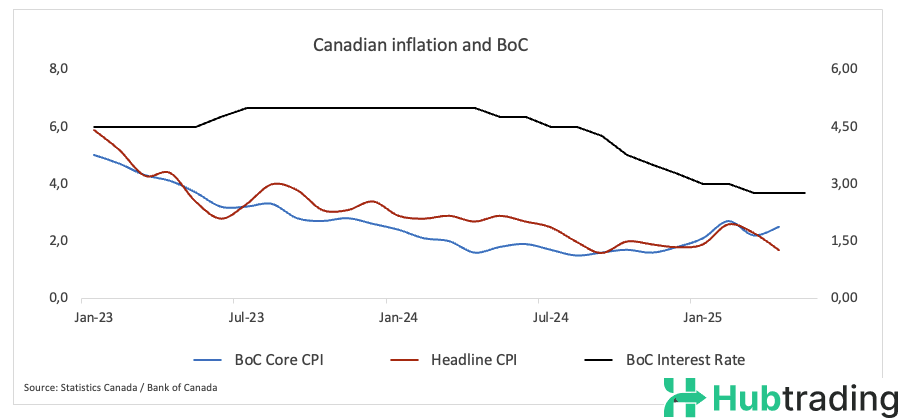-
Canadian inflation is expected to remain steady in May.
-
The headline Consumer Price Index (CPI) is projected to increase by 1.7% year-over-year.
-
The Canadian Dollar has come under increased selling pressure in recent days.
On Tuesday, Statistics Canada is set to release the Consumer Price Index (CPI) data for May, drawing close attention from markets as it offers fresh insight into inflation trends that influence the Bank of Canada's (BoC) interest rate decisions. Economists anticipate that headline inflation will hold steady at April’s annual rate of 1.7%. However, on a monthly basis, CPI is expected to rise by 0.5%, marking a notable rebound from April’s 0.1% decline.

The BoC will also publish its core inflation measures, which strip out volatile components to provide a clearer view of underlying price trends. In April, these core indicators rose 2.6% compared to the same period last year.
Despite signs of easing price pressures, analysts remain watchful of potential inflationary effects stemming from U.S. tariffs. The evolving inflation landscape has introduced greater uncertainty, prompting investors and policymakers alike to proceed with caution in the weeks ahead.
What to Expect from Canada’s Inflation Rate
Earlier this month, the Bank of Canada (BoC) held its benchmark interest rate steady at 2.75%, a move widely anticipated by markets. The central bank is taking a wait-and-see approach, opting to assess the full impact of U.S. tariffs before introducing any further stimulus. Since June 2024, the BoC has cut interest rates by a total of 225 basis points. However, Governor Tiff Macklem has signaled that more rate reductions could be on the table if trade-related headwinds worsen.
Currently, markets are pricing in about a 45% chance of a rate cut in July, with overnight index swaps suggesting roughly 36 basis points of additional easing by the end of the year.
In his post-meeting remarks, Governor Macklem highlighted the difficulty in isolating tariff effects within the headline CPI data. As a result, the central bank is placing greater emphasis on business sentiment surveys and soft indicators, many of which already point to rising input costs.
When Will Canada’s CPI Be Released and How Might It Affect USD/CAD?
Canada’s Consumer Price Index (CPI) data for May is scheduled for release on Tuesday at 12:30 GMT, and markets are bracing for signs of a potential inflation uptick.
Should the inflation figures exceed expectations, it could be viewed as early confirmation that U.S. tariffs are starting to exert upward pressure on prices. In that case, the BoC may adopt a more cautious policy stance, which could support the Canadian Dollar (CAD) in the short term. However, paradoxically, stronger inflation could also stoke fears about economic strain, potentially undermining the currency and complicating the rate-cut outlook.
The market reaction is expected to hinge not only on the headline number but also on how the data reshapes the broader narrative around inflation, growth, and monetary policy.
USD/CAD Outlook: Technical Levels to Watch
According to Senior Analyst Pablo Piovano of FXStreet, the Canadian Dollar has given up part of its recent gains, pushing USD/CAD from levels near 1.3540—last seen in early October 2024—toward the 1.3800 zone at the start of this week, marking fresh four-week highs.
“The return of a bearish bias could lead USD/CAD to retest its 2025 low at 1.3538, marked on June 16,” Piovano said. “Further support lies at the September 2024 trough of 1.3418, followed by the January 31, 2024 base at 1.3358.”
On the upside, Piovano noted that a stronger bullish push could lift the pair toward resistance at the 55-day Simple Moving Average (SMA) at 1.3827, followed by the May 29 high of 1.3860 and the May peak of 1.4015 set on May 12.
From a broader technical perspective, further downside may only resume if the pair breaks below its 200-day SMA at 1.4030.
Currently, USD/CAD is exhibiting signs of recovery, with the Relative Strength Index (RSI) approaching 56, suggesting growing bullish momentum. Meanwhile, the Average Directional Index (ADX) is trending down toward 26, indicating some fading strength behind the current move.





